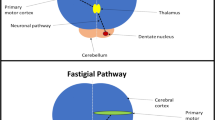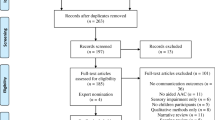Abstract
The purpose of this analysis was to document intelligibility and naturalness in ataxia, a neurological condition that results from cerebellar damage. The cerebellum is important for normal speech production to scale and coordinate articulatory and laryngeal movements. The disruption of these cerebellar mechanisms has unique implications for how intelligibility and naturalness are affected in ataxia. The results of research on speech in ataxia have important clinical implications for assessment and treatment of individuals with ataxic dysarthria. Speech samples from 27 participants with ataxia and 28 age- and sex-matched control participants were assessed by nine speech-language pathology graduate students for intelligibility and naturalness. Intelligibility was measured as the percentage of words transcribed correctly, and naturalness was assessed as a subjective rating on a seven-point interval scale. Both intra- and inter-rater reliability were moderate to high for both intelligibility and naturalness. Speech intelligibility and naturalness were robustly decreased in the ataxia group compared to the control group; however, the difference was greater for measures of speech naturalness. There were robust relationships among dysarthria severity, length of diagnosis, and speech naturalness in speakers with ataxia, but there were no other robust effects for age, sex, or impact on quality of life for intelligibility or naturalness. Speech naturalness was more impaired than intelligibility in speakers with ataxia. Impaired naturalness can have debilitating consequences for communicative participation, effectiveness, and quality of life. Assessment and treatment for ataxic dysarthria should include aspects of prosodic control for speech naturalness.




Similar content being viewed by others
References
Kent RD, Kent JF, Duffy JR, Thomas JE, Weismer G, Stuntebeck S. Ataxic dysarthria. J Speech Lang Hear Res. 2000;43(1–5):1275–89. https://doi.org/10.1044/jslhr.4305.1275.
Diener HH-C, Dichgans J. Pathophysiology of cerebellar ataxia. Mov Disord Off J Move Disord Soc. 1992;7(2):95–109. https://doi.org/10.1002/mds.870070202.
Gilman S, Bloedel JR, Lechtenberg R. Disorders of the cerebellum (No. 21). FA Davis Company. 1981.
Ghez C. Muscles: effectors of the motor systems. Principles of Neural Science. 1981;548–63.
Ito M. Movement and thought: identical control mechanisms by the cerebellum. In Trends in Neurosciences. 1993;16(11):448–50. https://doi.org/10.1016/0166-2236(93)90073-U (Elsevier).
Miall RC. The cerebellum, predictive control and motor coordination. Novartis Found Symp. 1998;218:272–90. https://doi.org/10.1002/9780470515563.ch15.
Spencer KA, Slocomb DL. The neural basis of ataxic dysarthria. The Cerebellum. 2007;6:58–65. https://doi.org/10.1080/14734220601145459.
Blaney B, Hewlett N. Dysarthria and Friedreich’s ataxia: what can intelligibility assessment tell us? Int J Lang Commun Disord. 2007;42(1):19–37. https://doi.org/10.1080/13682820600690993.
Yorkston KM, Beukelman DR. Ataxic dysarthria: treatment sequences based on intelligibility and prosodic considerations. Journal of Speech and Hearing Disorders. 1981;46(4):398–404. https://doi.org/10.1044/jshd.4604.398.
Yorkston M, Beukelman D. Communication efficiency of dysarthric speakers as measured by sentence intelligibility and speaking rate. J Speech Hear Dis. 1981;46(3):286–301. https://doi.org/10.1044/jshd.4603.296.
Duffy JR. Motor speech disorders-e-book: substrates, differential diagnosis, and management. Elsevier Health Sciences. 2013.
Ruano L, Melo C, Silva MC, Coutinho P. The global epidemiology of hereditary ataxia and spastic paraplegia: a systematic review of prevalence studies. Neuroepidemiology. 2014;42(3):174–83. https://doi.org/10.1159/000358801.
Van De Warrenburg BPC, Sinke RJ, Verschuuren-Bemelmans CC, Scheffer H, Brunt ER, Ippel PF, Maat-Kievit JA, Dooijes D, Notermans NC, Lindhout D, Knoers NVAM, Kremer HPH. Spinocerebellar ataxias in the Netherlands: prevalence and age at onset variance analysis. Neurology. 2002;58(5):702–8. https://doi.org/10.1212/WNL.58.5.702.
Bird TD. Hereditary ataxia overview. In: Adam MP, Mirzaa GM, Pagon RA, et al., editors. GeneReviews® [Internet]. Seattle (WA): University of Washington, Seattle; 1993–2022;1998 Oct 28 [Updated 2019 Jul 25]. Available from: https://www.ncbi.nlm.nih.gov/books/NBK1138/.
Dworkin LA, Goldman RD, Zivin LS, Fuchs PC. Cerebellar toxicity following high-dose cytosine arabinoside. J Clin Oncol. 1985;3(5):613–6. https://doi.org/10.1200/JCO.1985.3.5.613.
Evidente VGH, Gwinn-Hardy KA, Caviness JN, Gilman S. Hereditary ataxias. Mayo Clin Proc. 2000;75(5):475–90.
Fadic R, Russell JA, Vedanarayanan VV, Lehar M, Kuncl RW, Johns DR. Sensory ataxic neuropathy as the presenting feature of a novel mitochondrial disease. Neurology. 1997;49(1):239–45. https://doi.org/10.1212/WNL.49.1.239.
Haubrich C, Kleiser N, Kosinski C, Mull M, Kröger BJ, Esser D, Fimm B, Huber W. Episodic dysarthria related to vascular medullary compression. In Journal of Neurology. 2010;257(2):296–9. https://doi.org/10.1007/s00415-009-5348-3 (Springer).
Jen JC, Graves TD, Hess EJ, Hanna MG, Griggs RC, Baloh RW, Investigators C. Primary episodic ataxias: diagnosis, pathogenesis and treatment. Brain. 2007;130(10):2484–93.
Klein ES, Willbrand ML, Alvord LS. Cerebellar ataxia secondary to high-dose cytosine arabinoside (ARA-C) toxicity in treatment of acute leukemia: a case study. J Med Speech Lang Pathol. 1999;7(3):243–51.
Manto MU. Isolated cerebellar dysarthria associated with a heat stroke. Clin Neurol Neurosurg. 1996;98(1):55–6. https://doi.org/10.1016/0303-8467(95)00089-5.
Schmahmann JD, MacMore J, Vangel M. Cerebellar stroke without motor deficit: clinical evidence for motor and non-motor domains within the human cerebellum. Neuroscience. 2009;162(3):852–61. https://doi.org/10.1016/j.neuroscience.2009.06.023.
Shanmugarajah PD, Hoggard N, Currie S, Aeschlimann DP, Aeschlimann PC, Gleeson DC, Karajeh M, Woodroofe N, Grünewald RA, Hadjivassiliou M. Alcohol-related cerebellar degeneration: not all down to toxicity? Cerebellum & Ataxias. 2016;3(1):1–7. https://doi.org/10.1186/s40673-016-0055-1.
Wilkins A. Cerebellar dysfunction in multiple sclerosis. In Frontiers in Neurology (Vol. 8, Issue JUN, p. 312). Frontiers Media S.A. 2017; https://doi.org/10.3389/fneur.2017.00312
Folker J, Murdoch B, Cahill L, Delatycki M, Corben L, Vogel A. Dysarthria in Friedreich’s ataxia: a perceptual analysis. Folia Phoniatr Logop. 2010;62(3):97–103. https://doi.org/10.1159/000287207.
Poole ML, Wee JS, Folker JE, Corben LA, Delatycki MB, Vogel AP. Nasality in Friedreich ataxia. Clin Linguist Phon. 2015;29(1):46–58. https://doi.org/10.3109/02699206.2014.954734.
Ackermann H, Hertrich I. Speech rate and rhythm in cerebellar dysarthria: an acoustic analysis of syllabic timing. Folia Phoniatr Logop. 1994;46(2):70–8. https://doi.org/10.1159/000266295.
Darley FL, Aronson AE, Brown JR. Differential diagnostic patterns of dysarthria. J Speech Hear Res. 1969;12(2):246–69.
Gentil M. Dysarthria in Friedreich disease. Brain Lang. 1990;38(3):438–48. https://doi.org/10.1016/0093-934X(90)90126-2.
Joanette Y, Dudley JG. Dysarthric symptomatology of Friedreich’s ataxia. Brain Lang. 1980;10(1):39–50. https://doi.org/10.1016/0093-934X(80)90036-X.
Kent RD, Kent JF, Rosenbek JC, Vorperian HK, Weismer G. A speaking task analysis of the dysarthria in cerebellar disease. Folia Phoniatr Logop. 1997;49(2):63–82. https://doi.org/10.1159/000266440.
Kent RD, Netsell R, Abbs JH. Acoustic characteristics of dysarthria associated with cerebellar disease. J Speech Hear Res. 1979;22(3):627–48. https://doi.org/10.1044/jshr.2203.627.
Portnoy RA, Aronson AE. Diadochokinetic syllable rate and regularity in normal and in spastic and ataxic dysarthric subjects. Journal of Speech and Hearing Disorders. 1982;47(3):324–8. https://doi.org/10.1044/jshd.4703.324.
Ziegler W, Wessel K. Speech timing in ataxic disorders: sentence production and rapid repetitive articulation. Neurology. 1996;47(1):208–14. https://doi.org/10.1212/WNL.47.1.208.
Kent RD, Weismer G, Kent JF, Rosenbek JC. Toward phonetic intelligibility testing in dysarthria. J Speech Hear Disord. 1989;54(4):482–99. https://doi.org/10.1044/jshd.5404.482.
Yorkston KM, Strand EA, Kennedy MRT. Comprehensibility of dysarthric speech: implications for assessment and treatment planning. Am J Speech Lang Pathol. 1996;5(1):55–65. https://doi.org/10.1044/1058-0360.0501.55.
Yorkston K, Beukelman D, Strand E, Bell K. Management of motor speech disorders in children and adults. Austin, TX: PRO-ED. Inc.; 1999.
Manto M, Bower JM, Conforto AB, Delgado-Garcia JM, da Guarda SNF, Gerwig M, Habas C, Hagura N, Ivry RB, Marien P, Molinari M, Naito E, Nowak DA, Oulad Ben Taib N, Pelisson D, Tesche CD, Tilikete C, Timmann D. Consensus paper: roles of the cerebellum in motor control–the diversity of ideas on cerebellar involvement in movement. Cerebellum (London, England). 2012;11(2):457–87. https://doi.org/10.1007/s12311-011-0331-9.
Guenther FH. Neural Control of Speech. United Kingdom: MIT Press. 2016.
Tourville JA, Guenther FH. The DIVA model: a neural theory of speech acquisition and production. Lang Cognit Process. 2011;26(7):952–81. https://doi.org/10.1080/01690960903498424.
Spencer KA, Rogers MA. Speech motor programming in hypokinetic and ataxic dysarthria. Brain Lang. 2005;94(3):347–66. https://doi.org/10.1016/j.bandl.2005.01.008.
De Bodt MS, Hernández-Díaz Huici ME, Van De Heyning PH. Intelligibility as a linear combination of dimensions in dysarthric speech. J Commun Disord. 2002;35(3):283–92. https://doi.org/10.1016/S0021-9924(02)00065-5.
Hertrich I, Ackermann H. Temporal and spectral aspects of coarticulation in ataxic dysarthria: An acoustic analysis. J Speech Lang Hear Res. 1999;42(2):367–81. https://doi.org/10.1044/jslhr.4202.367.
Brendel B, Ackermann H, Berg D, Lindig T, Schölderle T, Schöls L, Synofzik M, Ziegler W. Friedreich ataxia: dysarthria profile and clinical data. Cerebellum. 2013;12(4):475–84. https://doi.org/10.1007/s12311-012-0440-0.
Cole J. Prosody in context: a review. Language, Cognition and Neuroscience. 2015;30(1–2):1–31. https://doi.org/10.1080/23273798.2014.963130.
Ladd DR. Intonational phonology. Cambridge University Press; 2008.
Kent RD, Rosenbek JC. Prosodic disturbance and neurologic lesion. Brain Lang. 1982;15(2):259–91. https://doi.org/10.1016/0093-934X(82)90060-8.
Liss JM, Spitzer SM, Caviness JN, Adler C. The effects of familiarization on intelligibility and lexical segmentation in hypokinetic and ataxic dysarthria. J Acoustical Soc Am. 2002;112:3022. https://doi.org/10.1121/1.1515793.
Liss JM, Spitzer SM, Caviness JN, Adler C, Edwards BW. Lexical boundary error analysis in hypokinetic and ataxic dysarthria. J Acoustical Soc Am. 2000;107(6):3415–24. https://doi.org/10.1121/1.429412.
Lowit A, Kuschmann A, Kavanagh K. Phonological markers of sentence stress in ataxic dysarthria and their relationship to perceptual cues. J Commun Disord. 2014;50:8–18. https://doi.org/10.1016/j.jcomdis.2014.03.002.
Trudeau S. CoRDS Registry, 2013;
Enderby PM, & Palmer R. FDA-2: Frenchay dysarthria assessment: Examiner’s Manual. Pro-ed, 2008.
Nasreddine ZS, Phillips NA, Bédirian V, Charbonneau S, Whitehead V, Collin I, Cummings JL, Chertkow H. The Montreal cognitive assessment, MoCA: a brief screening tool for mild cognitive impairment. J Am Geriatr Soc. 2005;53(4):695–9.
Walshe M, Peach RK, Miller N. Dysarthria impact profile: development of a scale to measure psychosocial effects. Int J Lang Commun Disord. 2009;44(5):693–715. https://doi.org/10.1080/13682820802317536.
Allison KM, Hustad KC. Impact of sentence length and phonetic complexity on intelligibility of 5-year-old children with cerebral palsy. Int J Speech Lang Pathol. 2014;16(4):396–407. https://doi.org/10.3109/17549507.2013.876667.
Kim H, Martin K, Hasegawa-Johnson M, Perlman A. Frequency of consonant articulation errors in dysarthric speech. Clin Linguist Phon. 2010;24(10):759–70. https://doi.org/10.3109/02699206.2010.497238.
Peirce J. PsychoPy-Psychology software for Python Release 2020.1.2, 2020.
Revelle WR (2017). Psych: Procedures for Personality and Psychological Research.
Koo TK, Li MY. A guideline of selecting and reporting intraclass correlation coefficients for reliability research. J Chiropr Med. 2016;15(2):155–63. https://doi.org/10.1016/j.jcm.2016.02.012.
Nalborczyk L, Batailler C, Lœvenbruck H, Vilain A, Bürkner P-C. An introduction to Bayesian multilevel models using brms: a case study of gender effects on vowel variability in standard Indonesian. 2019;62(5):1225–42. https://doi.org/10.1044/2018_JSLHR-S-18-0006.
Makowski D, Ben-Shachar MS, Chen SHA, Lüdecke D. Indices of effect existence and significance in the Bayesian framework. Front Psychol. 2019;0:2767. https://doi.org/10.3389/FPSYG.2019.02767.
Perkell JS, Lane H, Denny M, Matthies ML, Tiede M, Zandipour M, Vick J, Burton E. Time course of speech changes in response to unanticipated short-term changes in hearing state. The Journal of the Acoustical Society of America. 2007;121(4):2296–311. https://doi.org/10.1121/1.2642349.
Anand S, Stepp CE. Listener perception of monopitch, naturalness, and intelligibility for speakers with Parkinson’s disease. J Speech Lang Hear Res. 2015;58(4):1134–44. https://doi.org/10.1044/2015_JSLHR-S-14-0243.
Miller N, Noble E, Jones D, Allcock L, Burn DJ. How do I sound to me? Perceived changes in communication in Parkinson’s disease. Clin Rehabil. 2008;22(1):14–22. https://doi.org/10.1177/0269215507079096.
Pell MD, Cheang HS, Leonard CL. The impact of Parkinson’s disease on vocal-prosodic communication from the perspective of listeners. Brain Lang. 2006;97(2):123–34. https://doi.org/10.1016/j.bandl.2005.08.010.
Yorkston KM, Miller RM, & Strand EA (2004). Management of speech and swallowing disorders in degenerative diseases. Pro ed.
Eadie TL, Yorkston KM, Klasner ER, Dudgeon BJ, Deitz JC, Baylor CR, ... & Amtmann D. Measuring communicative participation: a review of self-report instruments in speech-language pathology. Am J Speech Lang Pathol. 2006;15(4):307–20.
Acknowledgements
We would like to thank the participants for their time and effort to participate in this study.
Funding
This research was funded by the NIH NIDCD F31 DC017877-01A1 and the Council of Academic Programs in Communication Sciences and Disorders.
Author information
Authors and Affiliations
Corresponding author
Ethics declarations
Conflict of Interest
The authors declare no competing interests.
Additional information
Publisher's Note
Springer Nature remains neutral with regard to jurisdictional claims in published maps and institutional affiliations.
Rights and permissions
About this article
Cite this article
Hilger, A., Cloud, C. & Fahey, T. Speech Impairment in Cerebellar Ataxia Affects Naturalness More Than Intelligibility. Cerebellum 22, 601–612 (2023). https://doi.org/10.1007/s12311-022-01427-y
Accepted:
Published:
Issue Date:
DOI: https://doi.org/10.1007/s12311-022-01427-y




